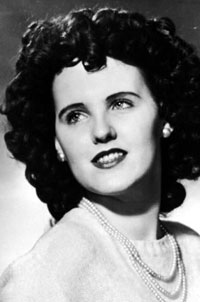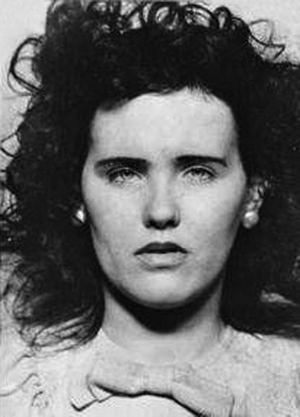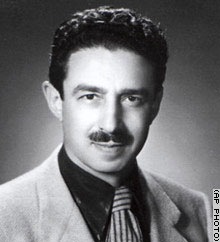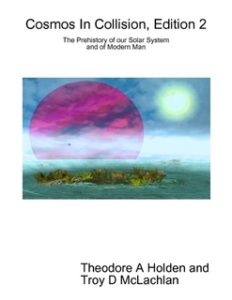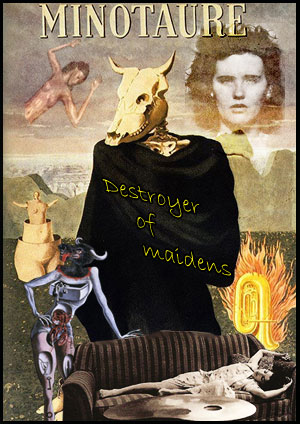 “The images are absolutely horrifying – but that is, unfortunately, what elite ritualized crime looks like. You have been warned.”
“The images are absolutely horrifying – but that is, unfortunately, what elite ritualized crime looks like. You have been warned.”
David McGowan (commenting on the crime scene and autopsy photos of Elizabeth Short): Inside The LC: The Strange but Mostly True Story of Laurel Canyon and the Birth of the Hippie Generation
Part XVIII
May 26, 2011
A key element in understanding the role played by the Saturn Death Cult in human history is to understand that it is not the sponsor of a particular conspiracy, but the sponsor of a culture of murder in which conspiracy can thrive. The operative word here is ‘culture’, and a major component of any expression of human culture is its artistic achievements. When ritualistic viciousness appears in the guise of art, especially that kind of art involving themes of sexual violence and human degradation, then what we have is clear evidence for a murderous culture of death permeating our society.
Between the 1920s and the late 1940s the violent libertine doctrines of an 18th century French aristocrat called the Marquise de Sade had become popular fare amongst so-called and self-styled ‘sexual sophisticates’. That particular era also embraced another notable contribution to a growing list of literature dealing with abusive sexual practises incorporating ritualistic undertones, the very strange Venus in Furs by Leopold von Sacher-Masoch. As late as the 1970s both authors remained banned in many western countries.
By the early 1950s the release of the infamous The Story of O by Pauline Reage capped a golden age of underground sexual subversion that would soon re-invent itself in the new and explosively loud cultural shock called rock ‘n’ roll. But the rebellious pouting of Elvis & co. would prove a poor substitute for those genuine aficionados’ of de Sade, Masoch and Reage. For such people the thrill of BDSM as a living philosophy could only be surpassed by its actual application to unwilling victims. Murder for sexual pleasure thus becomes the ultimate combination of artistic freedom and complete dominance over another human being.
In keeping with the inter-war years, we also find within their midst the almost incomprehensible crimes of two men of vastly differing social influence, yet with very similar psycho-sexual impulses. These two men shared a common interest that is crucial in understanding how this story unfolds and how a single, but not unique event in the Los Angeles of the 1940s belies the terrible truth that a hidden culture of murder and death still stalks us today, but has its roots in what many people consider to have been ‘the good ol’ days’.
In the US, the unassuming grandfatherly visage of one Albert Fish belied a dark sexually-driven tendency towards the kidnap, murder, cooking and consuming of pubescent girls. This after Fish had started life early with the joys of faeces eating before becoming a male prostitute, a profession he quickly expanded into the homosexual rape and torture of minors before his murderous rampage in the late 1920s.
Meanwhile, across the Atlantic in Europe, a certain Herr Schicklgruber was also experimenting with defecation as a way of achieving sexual domination over his partners; the particularly vile and humiliating act of forced coprophagia as it is known. Of course, Schiklgruber would ultimately be revealed to the world as one Adolf Hitler, and it’s often been assumed that the future German dictator’s faecal appetite was a prime cause in the potentially career-ending suicide of one of Hitler’s early girlfriends.
Even as the mid-twentieth century ground on towards the horrors of total war, nuclear annihilation and industrial scale genocides, writers like Henry Miller and Lawrence Durrell were gathering around the Villa Seurat with assorted Dadaists and existentialists to discuss the philosophical ‘virtues’ of incest, rape, torture, murder and sexual domination. These pioneers of four-letter word prose were complemented by the sub-artisan shock-tactics of the surrealist art movement which delighted in presenting to the world the image of a young girl’s eyeball being razored, amongst other things. Chief amongst this new generation of free-willed non-conformists was the photographer Man Ray, whose famous work ‘Minotaur’ is to play such an important part in this story.
And,… as this story goes. . . deep within the sunny suburbs of 1940s Los Angeles, a brilliant and wealthy Hollywood doctor whose specialty was the treatment of venereal diseases was gratefully absorbing and pondering upon the artistic and philosophical merits of all the afore mentioned; his name was Dr. George Hodel.
Meantime, and only a short car ride away from Hodel’s sunny upmarket suburban street, was the world of supposed aspiring actress Elizabeth Short, a world very much removed from that of the good doctor’s in terms of social status.
While there were very few men in Los Angeles with the refined education and social standing of Dr Hodel, the Los Angeles of the late 1940s was full of girls like Elizabeth Short. What most of these girls shared with the twenty-two year old Betty was the dream of experiencing a romantic liaison with a wealthy man they hoped would make them his wife. However, unlike the majority of her female contemporaries, Elizabeth Short’s experience of romance in the City of Angels was to be brutally tortured and mutilated, cut cleanly in half, drained of all her blood and finally and grotesquely displayed as an ‘exquisite corpse’ on a vacant Los Angeles section on January 15, 1947.
To the observer of the Saturn Death Cult legacy, Elizabeth Short’s murder seems a clear case of ritualistic murder. And as is pointed out in the quote at the beginning of this article, the results of elite ritual murder are seldom a pretty sight. But just how this can be claimed to be an example of elite ritual murder within culture of death that is the Saturn Death Cult is the subject of this writing.
****
Elizabeth Short’s case was sensationalised by press reports at the time as the Black Dahlia murder and it remains to this day possibly the most gruesome single unsolved murder in Los Angeles’ history. Her killer would later contact the media calling himself the Black Dahlia Avenger. According to one retired former Los Angeles homicide detective, the Black Dahlia Avenger was an elite Hollywood doctor involved at that time in illegal abortions and who had once been sensationally brought to trial and acquitted on charges of incest with his extremely young daughter. For those who have not yet connected the dots, the name of this doctor was George Hodel. Incredibly, he was also the father of the same former LA detective who has claimed that the former venereal specialist was the Black Dahlia murderer.
Former detective Steve Hodel had originally approached the Black Dahlia case with the intention of exonerating his father, a prime suspect with the LAPD in the notorious case. His investigations led him to produce a best-selling book on the subject in which he reversed his belief in his father’s innocence and identified him instead as the chilling reality behind the persona of the Black Dahlia Avenger.
One can only wonder at the effect this discovery must have on Steve Hodel, now in his later years, and who was only a youngster at the time of Short’s murder. Steve Hodel has gone on to link his father to a number of unsolved killings in the Los Angeles area as well as the disturbingly similar Chicago Lipstick killings in 1945 for which another man (innocent?) was convicted. Most recently, he has also sensationally claimed George Hodel was behind the Zodiac killings that terrorised San Francisco in the late 1960s. But that is another story. . .
Let’s just say that Steve Hodel’s family history is complicated, like just about everything else linked to the murder of Elizabeth Short. However, what is not complicated is the obvious ritualistic nature of the murder and the display of Elizabeth Short’s corpse in such a contrived manner. There is nothing complicated in coming to the conclusion that there was a ritualistic element to her murder – yet the question remains for this writer as to how deep and to what end were the ritualistic intentions of her killer?
At this point, I have to confess to not having read any of Steve Hodel’s published books on the subject. Instead, I have gleaned the majority of my conclusions from scouring his excellent website and many other related Internet sources. Consequently, this article does not attempt to analyse the evidence for and against George Hodel’s guilt, but rather looks to the insights we might gain on ritual murder as part of the landscape of elite Hollywood – particularly that of celebrity and elite ritual murder and its connection to the Saturn Death Cult legacy.
However, before going further with this discussion, I want to make clear that if there is one thing I am sure of, it is that Elizabeth Short would be absolutely horrified and humiliated that the aftermath of her suffering has now degenerated into an Internet freak show where her tortured, naked remains have been displayed for millions to thrill over. They are gruesome in the extreme and, for that reason, I have no intention of showing the images on this website.
(Steve Hodel has maintained a similar stance on his website with which I am in full agreement. Instead, to demonstrate the ritual aspects of her murder I will use reconstructions where appropriate – sanitized reconstructions. . Those of the Saturn Death Cult have enjoyed enough shock value out of Elizabeth Short’s agonizing death. At a later point in this article I will direct readers to a website with a comprehensive collection of Black Dahlia images and related artworks relevant to this story. However, you are warned as to the graphic nature of the images you will see)
In assessing my own knowledge of the murder, my first introduction to the Black Dahlia case was going to see the 1981 Robert De Niro movie True Confessions which was a fictional drama loosely based on the Elizabeth Short’s killing. I didn’t enjoy it. It was one of those movies that left an uncomfortable, empty feeling long after leaving the cinema. Years later I would stumble over images of Elizabeth Short taken while she was still alive. These were the over-used police mug shots taken after her arrest for underage drinking when she was nineteen. There is a lost look in eyes, probably a result of alcohol, yet they seem chillingly prophetic in hindsight.
Later, I would see the revolting photos of her desecrated corpse and the indecent autopsy images that now do the rounds in Internet shock&gore forums. The brutalities involved in this woman’s last hours are something almost impossible to comprehend. The ligature marks around the throat show signs of strangulation; the sinister ‘joker smile’ that had been carved into her cheeks from the corners of her mouth; the minute slits to her upper lip; the blunt trauma to the head that actually killed her; and the multiple cigarette burns to her back (proven by Steve Hodel to exist- see section 27.4 in this PDF). There are deep mutilations to her torso; the right breast, her left side and thigh, her pelvic region and genetalia; all sinister markings in the extreme with her body finally bisected at the waist.
Then there is the fact that she was made to eat faeces as part of her ordeal. It seems that, whoever her murderer or murderers were, they shared a similar interest in faeces eating with the above mentioned Messer’s Fish and Hitler and, indeed, the Marquis de Sade himself. The autopsy report also indicates Elizabeth Short suffered advanced dental decay, a sure sign she was living meal-to-meal and struggling to make ends meet. She was only twenty-two, in the prime of her youth, yet her health was a mess. In her final hours, the length of her torment is anyone’s guess – unfortunately there is no prescribed time for the length it takes to commit a ritual murder.
But what kind of a ritual (if any) and for what purpose was Elizabeth Short mutilated?
In trying to glean as much information on the subject as I could, I came across some comments on Steve Hodel’s website that gave me pause for thought when it came to the question of Elizabeth Short’s murder being a ritual act. The first was his reply to a question of whether prime suspect George Hodel would have had any occult/satanic influences as motive for murdering Elizabeth Short in such a brutal fashion. In my opinion, the query goes to the heart of what kind of man George Hodel was. I quote the exchange below:
By Kathie on June 7, 2009 11:41 AM
On the Beth Short.com website there was someone trying to establish a connection between Short’s death and the occult/Crowley. Have you found any evidence that your father was also interested in Crowley, or that Fred Sexton was?By Steve Hodel on June 7, 2009 1:01 PM
No. On the contrary, everything that I know about my father would point in the opposite direction. Being a man of science (as well as a Misanthrope and Nihilist) he had zero interest or beliefs in any “isms” or philosophies. In conversations with me, he made it clear that he had total disdain for anything metaphysical or “occult.” That is not to say that he didn’t identify and personally subscribe to the thoughts of a kindred spirit such as the Marquis De Sade, but that was personal and private. George Hodel was a loner, not a joiner. Can’t speak for Fred Sexton, but I seriously doubt it.(See the comments section on this website post)
The above is highly significant because, if indeed George Hodel was Elizabeth Short’s killer, we have a case of a confirmed non-occultist engaging in seemingly ritual-like activities during the murder of his victim. The implication is that murderous rituals are not necessarily confined to the actions of occultists and religious practitioners. In the case of George Hodel, the implication is that these types of ritual are actually an indication of those who seek control and power over others.
When I said that the above exchange goes to the heart of what kind of man George Hodel was, it also goes to the heart of what kind of entity the Saturn Death Cult is. The driving force behind such ritualistic acts is revealed to be the pursuit of ‘power’, followed by the recognition of that power by others – ritual merely becomes its mechanism.
While I agree with Steve Hodel that his father’s psychological profile precludes his being a ‘joiner’ of any existing cult or group, there is an argument to be made that George Hodel might still have sought recognition from those he would have considered his peers. This may have been important to him in spite of the obvious police scrutiny a public display of his alleged murderous activities would inevitably bring. However, the desire to reach out to an appreciative audience of like-minded peers would justify the risk and serve as validation of his private misdeeds.
For want of a better description, this postulated appreciative audience of peers can be identified as those belonging to a class of people calling themselves the ‘aristocracy of purpose’, a term used by renowned Bilderberger observer Daniel Estulin to describe those elitists who aspire to dictate the affairs of mankind from behind the scenes. In the case of George Hodel, his prospective peers would seem to have been those elitist artists active in the spheres of art and celebrity.
That the Marquis de Sade has continued to this day to enjoy posthumous celebrity status is well known. The French aristocrat’s literary efforts continue to influence would-be misanthropes and it is noteworthy that Steve Hodel points to the Marquis as a possible ‘kindred spirit’ to his father. What we do know is that the Marquis’ writings formed a part of George Hodel’s personal library with a good proportion of de Sade’s narratives focused on victims being forced to eat faeces, amongst other more unsavoury acts. It must be remembered that Elizabeth Short’s autopsy revealed she was forced to eat faeces.
But Steve Hodel’s above quoted answer also states that he considers his father to have cultivated a ‘loner’ type of mindset. It is important to note here that this is entirely in keeping with the mindset of those who aspire to be artists. While most artists seek acclaim for their efforts, their techniques and base motives are often kept private. Artists are notoriously wilful people obsessed with their own ends, while often displaying very child-like temperaments in pursuing their objectives. This is not to say that George Hodel was artistic, but rather that, like most aspiring artists, he wilfully sought acclaim for his work, yet shunned illumination of its practice – understandably so, because even at this jaded stage of human moral development, murder for art’s sake is still somewhat frowned upon.
In a highly original take on the infamous murder, the authors Mark Nelson and Sarah Hudson Bayliss attempt to make a case in their book Exquisite Corpse: Surrealism and the Black Dahlia Murder for the deliberate inclusion of surrealist motifs by the killer on the corpse and in the corpse’s display. Primarily, the contrived configuration in which Elizabeth Short’s upper torso was found shares remarkable similarities to the composition of the Man Ray work called Minotaur, a photo replete with popular surrealist symbolism and archetypes. But it doesn’t stop there.
The motif of the dissected naked female torso was a dubious staple of the surrealist movement’s repertoire. The concept has adorned copious works by various artists before and after Elizabeth Short’s horrific murder. In fact, there are so many surrealist symbols and motifs inherent in the Black Dahlia crime scene that one is almost overwhelmed by the obvious parallels between this art-style and the Black Dahlia’s hideous reality. (See here for a shocking comparison of Black Dahlia ‘appearances’ in the world of surrealist art – be warned; graphically disturbing images)
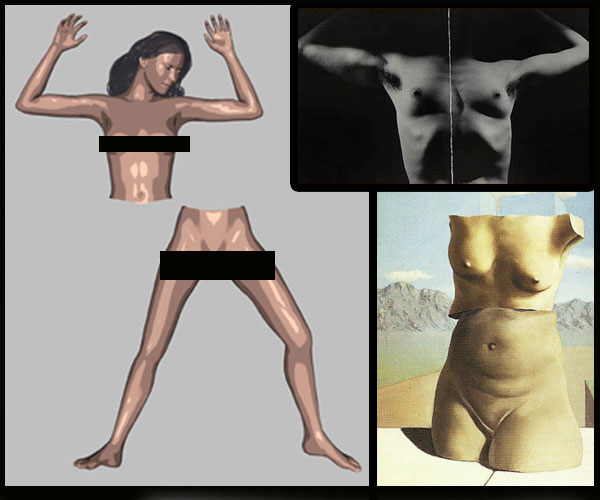
The dissected female torso is a frequent motif in surrealis art: A sanitized 3D reconstruction of the Black Dahlia murder scene (left) compared with ‘Minotaur’ by Man Ray (top right), and a detail from René Magritte’s ‘Marshes of Summer’, 1939
The possibility of George Hodel as aspiring murder-artist provides us with a possible catalyst for the turning of a pathetic act of sexual domination and murder into a monstrous advertisement of intent. The studied posing of Elizabeth Short’s bisected torso becomes a symbolic statement to be understood by those with eyes to see. In this we can see how her carefully displayed body may have indicated a need on the part of the killer to incorporate recognisable ritualistic archetypes and symbols into the corpse of Elizabeth Short as a statement of arrival into rarefied circles. It explains why Elizabeth Short had to become an ‘exquisite corpse’, and not just another sex-crime statistic.
The highly disturbing conclusion here is that, as far as George Hodel was concerned, being part of the gang by proxy of his macabre meat sculpture served not only to elevate him to the status of fellow artist, it also served as the ultimate act of one-upmanship – while his peers merely painted and photographed facsimiles of the destroyed female torso, he actually did it!
The surrealist art movement was entering its twilight at the time of Elizabeth Short’s murder, though there is no evidence to suggest Man Ray or any of his fellow dadaists had anything to do with her death. Interestingly, Steve Hodel is able to confirm that Man Ray and George Hodel enjoyed a close personal friendship, so it is safe to assume that Hodel held the Dadaist photographer in high regard. Maybe Man Ray was a ‘kindred spirit’ in the de Sade cast in George Hodel’s mind.
As an aside, and contrary to popular misconception, the Marquis de Sade, was not an occultist, nor was he a Satanist. In fact he was the complete opposite to the likes of famed black magician Alistair Crowley in that de Sade sought to expose all he was to the world, including his darkest and most demented views on human morality. This is not the way of the occultist who, by the very nature of their calling, hide their intentions and practises from the uninitiated, even though some may share the underlying nature of de Sade’s style in attacking the accepted values of society, i.e. the “do what thou will” adage so popular in occult circles.
However, the true link between your common garden variety occultist and adherents to de Sade’s frightening brand of hedonism, those such as George Hodel, is found in a shared definition of the concept of freedom. This is loosely defined as the will of the individual to prove they can ascend to true freedom via quasi acts of ritual or outright acts of savagery. The problem is, however, that these ritualistic-like demonstrations towards attaining freedom often mean the involuntary loss of freedom for other less willing participants. In fact, the concept of ‘freedom’, according to those with a de Sade mindset, directly translates into the explicit removal of freedom for others as the ultimate act of freedom itself! Is it any wonder that such inherently contradictory actions need to be conducted far away from the prying eyes of an incredulous and often judgemental society?
What this indicates is that, within certain circles, the application of ritual acts of rape, torture and murder are the direct consequences of an immature concept of self-worth. These crimes thus become the misapplied, yet ‘legitimised’ means for an individual or group of individuals of demonstrating the will to power. Simply put; the aim is not merely to dominate; it is to prove to others one’s dominance. Only in this way is a selected individual truly initiated into the ranks of those who attain so-called self-determination. Pathetic as it sounds, this is considered amongst certain types as proof of one’s elite status, i.e. true freedom!
However, there is a fly in their ointment. The demonstration of one’s dominance over others is, by its nature, fleeting when the subject (victim) of such a demonstration is its only actual witness. Whatever satisfaction and applause is gained by their shrieks and screams and the terror reflected in a chosen victim’s eyes is lost when the last flicker of life flees their extinguished bodies. The nagging question of doubt in the killer’s mind is: What is left to prove one’s ‘worthiness’ in achieving so-called freedom to ‘do what thou wilt?’
Que the macabre technique of making a recording of the crime in the form of photos, audio recordings and films. However, even this eventually fails to re-invoke the warped sense of self-worth gained from the victim’s original agony – unless one displays such terrible things to an appreciative and knowing audience. . . Hence the crime scene as an artist’s canvas.
To this end, the hidden and lone act of murdering Elizabeth Short was in itself unable to provide the necessary applause needed by the likes of George Hodel, no matter how unspeakable the crime. The mere memory of the act would have eventually proved insufficient in sustaining the original high. Worse, her murder as an attempt at self-initiation into the ranks of those George Hodel admired risked the unforgivable outcome of slipping into obscurity.
To avoid the intolerable fate of obscurity, George Hodel’s personality would have led him to conclude that only the most heinous secret act resulting in total public outrage would be sufficient to ensure that he would be spoken of in knowing circles for years to come. In this way he could firmly establish himself as a man of consequence and satisfy his private need to be of significance amongst those who mattered.
However, the lengths George Hodel was willing to go to achieve this aim seems to have been tempered by an obsession with maintaining a safe distance from the consequences of his alleged crime. This clearly points to a potentially serious flaw in the character of Dr. George Hodel and others like him; George Hodel was at once both a narcissist and a coward. And it is this flaw of character that ultimately links the ritualistic elements in Elizabeth Short’s murder to the legacy of the Saturn Death Cult, for all acts attributed to the Saturn Death Cult are the pathological acts of narcissists and cowards.
To prove this point, one has to consider that the only way George Hodel could have triggered recognition of his achievements amongst those he sought to impress would have been to frame the consequences of his actions in the archetypes and symbols familiar to those whose recognition he craved. And the only way he would have known which archetypes and symbols to use would have been because he was schooled and studied in them – schooled by others already experienced in their application and practise.
By indicating that the Marquis De Sade was a ‘kindred spirit’ to his father, Steve Hodel has inadvertently linked all followers and practitioners of the Marquis’ vicious brand of amoral philosophy to his father’s alleged actions. In identifying signature surrealist art motifs with the hideously mutilated and bisected corpse of Elizabeth Short we are led to associate an entire art movement and its most famous exponents as occult observers of an unspeakable riddle within a shocking crime. In analysing these same motifs, particularly Man Ray’s minotaur motif, we are consequently given a key in connecting the Black Dahlia murder to a distinct Saturnian mythological element – the grandson of Zeus, great grandson of Kronos/Saturn, the half-man, half-bull son of Minos, the Minotaur, destroyer of maidens.
It is for these kindred spirits, men and women receptive to the symbols displayed in Elizabeth Short’s grotesquely arranged corpse, whom we can assume that George Hodel truly wanted to pay homage. Despite being a loner, George Hodel’s alleged involvement in the ritualistic-like abuse of Elizabeth Short’s body wold belie a keen understanding on the part of the killer of what it takes to participate in a death cult, even if carried out behind the protective privacy of a symbolic curtain used to separate himself from his fellow death cultists.
By leaving Elizabeth Short’s mutilated corpse in a state of redressed pose, that most grisly of crime masterpieces, George Hodel seems to have declared a self-conceived notion of having attained a level of true self-realisation that only the murder and desecration of another human being can bring. The unique conclusion is that George Hodel may have been the first killer whose recognised modus operandi was art, albeit a murderous art. As a true destroyer of maidens, George Hodel had become surrealism’s Minotaur Incarnate!
Thus we arrive at the link between the Black Dahlia and one of Saturnian mythology’s most disturbing stories; The Minotaur. But it remains a tenuous assertion without further investigation – investigation that must examine more closely the links between the Minotaur, Saturnian mythology and the Dadaist/Surrealist art movement.
In bringing part one of this story to a close, I doubt George Hodel had the slightest interest in the Minotaur’s links to Saturn and the role Saturn plays in occult circles, let alone the idea that history’s major events are the consequences of diverse groups driven by Saturn-obsessed agendas. So how can one honestly link the murder of Elizabeth Short to the concept of a historical Saturn-based death culture?
To answer this question one must challenge the concept of George Hodel as the consummate ‘loner’ and look more deeply into the surrealist art movement of the inter-war years. Then one can start to connect George Hodel’s alleged masterpiece of horror to a death cult agenda. As a clue to what’s to come, know that George Hodel was also, amongst many things, a military man. Not only that, but specifically served in military intelligence. And herein, as the surrealists would say, lies a riddle wrapped in a mystery inside an enigma. . .
Stay tuned for The Minotaur & The Black Dahlia Avenger – Part 2 (Coming eventually).

